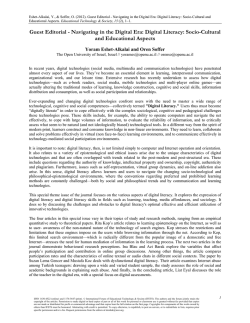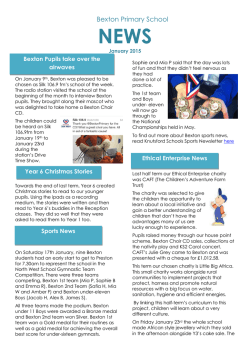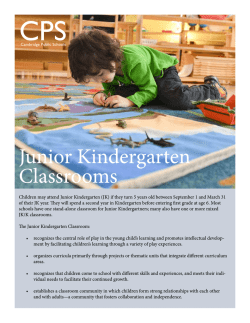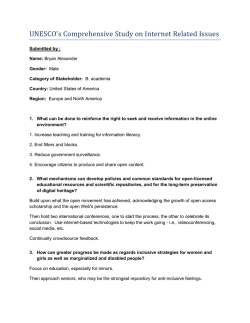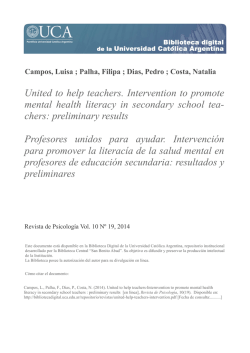
Communications in Information Literacy
Volume 4, Issue 1, 2010 [ARTICLE] AIMING FOR ASSESSMENT Notes from the Start of an Information Literacy Course Assessment Peter Larsen University of Rhode Island Amanda Izenstark University of Rhode Island Joanna Burkhardt University of Rhode Island ABSTRACT To provide systematic assessment of a 3-credit, full-semester information literacy course at the University of Rhode Island, the library instruction faculty adapted the Bay Area Community College Information Competency Proficiency Exam to determine how well the students learned the material taught in the course and how well that material reflected the ACRL Information Literacy Competency Standards for Higher Education. 61 Larsen, Izenstark & Burkhardt, Aiming for Assessment Communications in Information Literacy 4(1), 2010 INTRODUCTION libraries of URI. The program began in 1999, when Mary McDonald and Joanna Burkhardt offered a single section of the nascent course, teaching 10 students. Over the following decade, it grew to a regular semester offering of 7 to 8 sections of 25 students each, plus 1 to 2 sections in the summer semester (offered as a distance education class via WebCT). Recently, another 2 face-to-face sections serving the university’s Talent Development Summer Pre-Matriculation Program have been launched in the summer semesters as well. Over the past decade, most institutions of higher education have adopted information literacy (IL) as a goal for their students. There are a great many ways to satisfy this goal—online tutorials, workshops, information literacy-focused courses, bibliographic instruction sessions embedded in non-library courses (often Composition and Writing courses for general education goals), training non-librarians to provide information literacy skills as part of their courses,and more approaches are no doubt being developed. At the University of Rhode Island (URI), faculty librarians have taken a leadership role in providing instruction to meet that goal. In addition to a substantial general program offering two 1hour library sessions to all incoming freshmen and broad subject-specific library instruction, the library faculty have created online tutorials, a subject-focused undergraduate, 1-credit information literacy course offered as a supplement to other courses (LIB 140), a graduate course on library research in the biological sciences (BIO 508/LIB 508), and a 3-credit course in general information literacy and library research methods (LIB 120). As the URI libraries' information literacy program has matured, faculty librarians realized the need for assessment to establish the value and effectiveness of the program and to gather data for planning for growth and future development. While assessment projects are underway for all facets of the information literacy program at URI, this paper concentrates on the assessment of LIB120. The course covers research techniques, focusing heavily on library resource use but also addressing the web and non-scholarly research needs. It also deals with information issues, including plagiarism, copyright, and freedom of information. Most sections of the course are populated by a mix of students both in terms of year in school and major. However, most years a few of the sections are heavily populated with students of a single major (for example, nursing strongly encourages its students to take the course), and the examples and exercises are modified slightly to address the specific information needs of the students. The Decision for a Large-Scale Assessment Project As the course developed over its first few “experimental’ semesters into a mature form, faculty librarians wanted to assess it beyond the standard university-level Student Evaluation of Teaching (SET) forms distributed to every URI class at the end of each semester. By 2001, most of the sections had adopted a more detailed assessment tool produced by URI's Instructional Development Program (IDP), which generated a fuller image of student satisfaction than the standardized Background on LIB120: Introduction to Information Literacy As previously mentioned, LIB120 is a 3credit, full semester course offered by the 62 Larsen, Izenstark & Burkhardt, Aiming for Assessment Communications in Information Literacy 4(1), 2010 was meeting the goals of the Information Literacy Plan. Second, establishing a standardized syllabus was a primary goal, and a standardized assessment tool would help with that. Third, United States higher education is keenly interested in assessment, and URI is no exception. By selecting and administering an assessment tool early, the program could proactively explore an area of national interest and also have the freedom to select and develop a tool that fully met the needs of the program, rather than waiting for the university to mandate a more standardized tool less useful for the specific needs of LIB120. Fourth, because the university was undergoing its decennial accreditation process under the New England Association of Schools and Colleges (NEASC) during 2007, the university urgently needed data to evaluate the libraries' contributions to the university. Last, but most definitely not least, the genuine desire for continual improvement of the course required assessment data to clarify decisions and identify areas of strength and weakness. SETs. This tool, while extremely useful, lacked a way to gauge specific learning outcomes in a rigorous manner. The instructors had a good sense of how the students felt about the course, but they lacked solid data on whether the students were learning the lessons the course intended to teach. Between 1999 and 2004, faculty used pre- and post-testing in some sections to attempt to gauge student learning outcomes in a comprehensive way. These results were useful locally, but a lack of uniform administration of the tests across the sections limited their usefulness overall. Subsequent sessions of a single section could be compared, but sections could not be easily compared with each other, much less against a national picture. An additional issue involved uniformity of section content. Over the decade of development, 15 instructors taught approximately 2000 students in more than 90 sections of the course. Instructors modified the syllabus to support their individual teaching styles, and, while these modifications produced effective lessons and clever and engaging assignments, by 2005 it was time to bring the sections back to a uniform syllabus. A course-wide assessment project seemed like a natural part of that effort. LITERATURE REVIEW A review of the literature reveals no similar projects. Few colleges or universities have credit-bearing, standalone information literacy courses, and, as of the writing of this article, no articles have been published on the topic of using a standardized exam to assess student learning in these courses. While not an exhaustive review, what follows are examples of IL assessment efforts. Why Assess? There were a number of clear reasons why LIB120 needed rigorous assessment. First, the Association of College and Research Libraries (ACRL) Information Literacy Competency Standards [http://www.ala.org/ a l a / a c r l / a c r l s t a n d a r d s / informationliteracycompetency.cfm] make up the backbone of the URI General Libraries' Information Literacy Plan [http:// www.uri.edu/library/instruction_services/ infolitplan.html]. An assessment tool that also mapped to those standards would go a long way toward demonstrating that LIB120 Assessment is by no means a new topic, however. A broad overview of assessment is provided in a paper presented at the ACRL conference in 1997, “Assessment of Information Literacy: Lessons from the Higher Education Assessment 63 Larsen, Izenstark & Burkhardt, Aiming for Assessment Communications in Information Literacy 4(1), 2010 portfolios (Diller & Phelps, 2008). Movement” (Pausch & Popp, 1997). Bonnie Gratch Lindauer’s article ”The Three Arenas of Information Literacy Assessment” discusses the overlap and relationship among the learning environment, information literacy program components, and student learning outcomes when considering methods of assessment (2004). Surveys and questionnaires have been used, alone or in conjunction with other tools. A 1996 article revealed results of a survey administered at Kent State University (Kunkel, Weaver & Cook, 1996). At Concordia College, librarians used both bibliographic analysis and questionnaires about use of specific library resources to assess student learning (Flaspohler, 2003). Librarians at Cornell University combined surveys, a pre-test, and gap-measure assessment to elicit more valuable data (Tancheva, Andrews & Steinhart, 2007). Assessment can take any of a variety of forms: bibliographic analysis, rubrics, portfolios, surveys, pre- and post-tests, and/ or exams. Analysis of student bibliographies has long been used to assess students’ information literacy skills. In one such instance, Karen Hovde (2000) reported on the use of bibliographic analysis of freshmen research papers to assess the effectiveness of library instruction. Pre- and post-tests may be used as standalone tools or as part of a larger assessment. Researchers at East Carolina University successfully used the same 40 questions as both a pre-test and a final exam to assess student learning in a 1-credit course (Langley 1987). More recently at Central Missouri State University, an anonymous and optional pre-test was used to acquire an initial snapshot of student information literacy skills in a credit course. The same questions were incorporated in the course’s larger comprehensive final exam, providing some data regarding how students’ skills had changed over the course of the semester (Lawson, 1999). One recent study discusses the development and implementation of a writing assignment rubric based on the ACRL Information Literacy Standards (Knight, 2006), while another examines the use of a rubric in more specialized IL instruction for graduate students in chemistry (Emmett & Emde, 2007). The use of portfolios for assessment is described in a small case study by Valerie Sonley, Denise Turner, Sue Myer and Yvonne Cotton (2007). A “Paper Trail” portfolio including assignments and emphasizing reflection was successfully introduced as an assessment tool in an information literacy and communication course at State University of New York (SUNY) Brockport (Nutefall, 2004). (The Paper Trail portfolio project has long been an assessment tool for LIB120.) In an effort to utilize authentic IL assessment methods, librarians at Washington State University Vancouver developed rubrics used to evaluate students’ electronic A number of standardized tools have been developed for IL assessment. The iSkills test started as the ICT Literacy Assessment, and Stephanie Sterling Braseley's article “Building and Using a Tool to Assess Info and Tech Literacy” (2006) provides an overview of the development and implementation of the test. Katz (2007) provides an update and some analysis of the test's implementation and results. While the iSkills test assesses both IL and technology competency, James Madison University developed a test to solely assess information 64 Larsen, Izenstark & Burkhardt, Aiming for Assessment Communications in Information Literacy 4(1), 2010 seemed most appropriate: the Educational Testing Service's (ETS) ICT Literacy Assessment Test, Project SAILS, and the Bay Area Community College Information Competency Proficiency Exam (BACC). The ETS instrument (now called iSkills) had the advantages of professional support (ETS administers many nationally recognized tests including the GREs and the SATs), a national range for comparison purposes, and longitudinal support. Its disadvantages included significant cost, a focus on undergraduates near graduation, rather than on the incoming students that make up the bulk of LIB120's enrollment, and an emphasis on computer and technology skills, rather than on information literacy concepts. Project SAILS, created by Kent State and the Association of Research Libraries (ARL) was more in tune with the ACRL standards but had been put on a 1year hiatus just before the URI project started. The last instrument, created by a cooperative group of California Community Colleges, turned out to be nearly ideal. It was "open source," mapped directly to the ACRL standards (with the exception of Standard 4, which is already well assessed through the LIB120 grading criteria), and offered both national relevance and the opportunity for customization. Instructors chose the BACC instrument for a pilot project in the fall semester 2006. literacy based on the ACRL standards (Cameron, 2007). Project SAILS was developed out of a need for a standardized, valid, and reliable tool to measure information literacy at Kent State University (Blixrud, 2007), and the Bay Area Community Colleges Information Competency Assessment Project was developed out of a need to allow students to show information competency in lieu of taking a required course (Smalley, 2004). (previous text not a sentence as written.) Florida Community College requires that students demonstrate information literacy competency by completing standardized computer-based modules, with or without taking an information literacy course (Florida Community College, n.d.). Finally, Teresa Y. Neely's Information Literacy Assessment: Standards-based Tools and Assignments (2006) lists the aforementioned Bay Area Community Colleges Assessment Project and Radcliff et al.'s A Practical Guide to Information Literacy Assessment for Academic Librarians (2007) as information literacy survey instruments. In the book, Neely’s goes provides an overview of assessment techniques and their potential uses, along with explanations how to analyze and use data gleaned from assessment tools. Assessment Instruments METHODOLOGY After exploring the option of designing an instrument, the instructors decided that a field tested, regional or national test instrument was required to not only identify the URI program's student learning outcomes but also to compare those outcomes to those of other students at other institutions. Additionally, such an instrument would reduce the chance of design error and ensure accurate results. After initial investigation, three instruments The instructors carefully examined the BACC instrument for appropriateness and applicability. Individual questions were adapted to local needs as necessary (e.g., replacing images to match the catalog used by URI), although the instrument was modified as little as possible to maximize the usefulness of comparing URI data with that of other institutions. After all the questions had been answered, the instrument 65 Larsen, Izenstark & Burkhardt, Aiming for Assessment Communications in Information Literacy 4(1), 2010 the number of available computers, most students could reschedule for the "other exam day" with no problem. One last problem with the WebCT format was deciding how much of the results to release to students. For example, course management software gives instructors wide latitude in showing total scores, scores on individual questions, correct answers, and instructor comments.. After some debate, the instructors decided to release only the final grade to the students to preserve the exam for use in future semesters. was transferred into URI's course management software (WebCT) and reappraised for accuracy and usability. The instructors chose an online delivery system for ease of grading and data collection, as well as allowing students to move back and forth between searching the catalog and other electronic tools and recording their answers. Online delivery also made it possible to directly compare the sections delivered partly or fully online with the "brick and mortar" sections. The instrument was administered as the final exam to all LIB120 students during the standard 3-hour final exam slots. Because of security concerns, rather than using the standard exam times for each session, the course used the common exam slots; and exam sessions were scheduled into the library's three computer labs. Individual instructors graded the exams and forwarded them to a central email address for analysis. After assessing the first set of results, the exam was further modified to identify problem questions and fix errors in formatting. "Problem questions" were defined as questions for which at least 50% of the students selected the wrong answer. These questions were re-examined and divided into three categories: questions for which the wording legitimately interfered with the students' ability to correctly answer the question because of differences in terminology or other local issues (these questions were altered); questions insufficiently addressed by the course content (instructors revised content); and questions that students simply failed to answer correctly (these questions were left as is). Since this revision, the exam has remained unchanged except for minor alterations required by the online format. The exam has been used in every section offered in the four fall and spring semesters since fall 2006, and in two of four sections offered during the summer 2007 sessions. Because this was the first time LIB120 had used an online exam, every effort was made to create redundant systems to ensure a smooth process. The instructors created paper copies of the exam in case of major internet problems, and the library IT staff was standing by to troubleshoot potential access problems. Fortunately, problems were few and easily fixed. A few students who had not used their WebCT accounts had trouble logging on. (To address this problem, the next semester two short WebCT quizzes were built into the syllabus to give the students practice with the exam format and to make sure that they were all able to log on to WebCT before the day of the exam.) A larger problem was the physical scheduling of exam space. Because the common exam slots are used by many multiple-section courses, scheduling conflicts were common. Fortunately, since the sections had to be split between 2 days because the number of students was double INITIAL RESULTS The LIB120 Instructors Group set a benchmark of 70% as a grade showing competency in information literacy. Students took the exam and instructors graded each exam via 66 Larsen, Izenstark & Burkhardt, Aiming for Assessment Communications in Information Literacy 4(1), 2010 more experience with research, which might affect their scores on the exam. They might also have a higher comfort level with college courses in general, reducing anxiety levels and making test-taking less stressful. Freshman students often have a range of challenges in the transition from high school to college (first time away from home, balancing work and school, social adjustment, etc.) that might result in reduced study time and lower test scores. The test score averages by year in school are listed in Table 2. WebCT. During the pilot semester, a WebCT feature automatically sent the ungraded exam to an email address when the student selected "finished." Summary statistics for each section, including information about how many students answered each question correctly, were submitted to the email account by each instructor. However, grading for some questions allowed a range of points to be awarded. The exam summary generated by WebCT did not include grading for the questions for which a range of points could be awarded. By the time this error was discovered, the information had been overlaid by the next semester's WebCT course. For the following semesters, exams first were corrected and copied, student names were replaced by the instructors name and a number, and the exams were sent to the test email account for analysis. The average scores for each semester are listed in Table 1. One benefit of using the Bay Area C o m m u n i t y C o l l e g e I n for m a t i o n Competency Assessment Instrument is that each question maps to the appropriate ACRL Information Literacy Standard (s). This makes it possible to sort results to see how well students do with respect to each standard, highlighting those standards for which students are excelling or falling down, and indicating areas where teaching may need adjustment (see Table 3). After the pilot semester in the fall of 2006, the question arose whether a student's year in school might have some bearing on exam performance. Upperclassmen might have Finally, with 70% set as a passing score showing competency in information TABLE 1 — AVERAGE TEST SCORES PER SEMESTER Average Score Fall ‘06 Spring ‘07 Summer ‘07 Fall ‘07 Spring ‘08 75.0 80.1 85.8 83.2 81.2 TABLE 2 — TEST SCORE AVERAGES BY YEAR IN SCHOOL Average score by year in school Spring ‘07 Summer ‘07 Fall ‘07 Spring ‘08 Freshman Sophomore 80.2 80.4 88.6 73.6 81.6 83.2 79.0 80.8 Junior 79.9 90.8 85.6 82.3 Senior 80.9 86.5 85.6 82.8 67 Larsen, Izenstark & Burkhardt, Aiming for Assessment Communications in Information Literacy 4(1), 2010 literacy, the data revealed that approximately 10% of the students failed to reach this level every semester. Most were freshmen. the instructor's group endeavored to determine the root of the problems. For example, questions involving citations were problematic because the WebCT programming was not able to correctly render URLs in MLA citation format. For example, the angle brackets used in MLA format caused WebCT to assume the contents of the brackets were HTML code, resulting in the contents not being displayed. To remedy this, instructors announced at the beginning of the exam that students should not use angle brackets when constructing citations in this instance. For another question asking for the result of a particular Internet search string, it appeared that students simply did not take the time to check that the answer they selected was correct because the point value for the question was too low. ANALYSIS This instrument did indeed test students' knowledge, returned some valuable information about what they learned, whether they could apply what they learned in a new situation, and what they did not learn. This allowed the instructors to reexamine the structure of the course and to adjust time allotments and emphasis on problem concepts and skills. Analysis showed that the majority of the students met the 70% grading benchmark set for showing information literacy competency. Although originally intended to gather data and improve the course, it became apparent that the resulting data reflected more than just what students learned. It also provided data on the test itself. Analysis revealed that students consistently answered some questions incorrectly, prompting further investigation and consideration about the wording of the question and about the presentation of instruction related to the question. F i n a l l y , t h i s a s s e s s me n t t e s t e d teaching. The results pointed out to individual instructors the concepts and skills that were difficult for the students and, therefore, those concepts that instructors needed to approach in a new way, devote more time to, and/or emphasize more. The similarity of the results from one section to the next assured the instructors that everyone was providing the course content evenly and that students were achieving approximately the same outcome no matter Of the questions that presented problems, TABLE 3 — TEST SCORE AVERAGES BY ACRL STANDARD Fall 06 Spring 07 Summer 07 Fall 07 Spring 08 Standard I 85.9 81.7 82.6 87.6 82.3 Standard II 74.9 73.4 76.3 76.7 78.8 Standard III 73.3 71.2 74.3 74.0 73.7 Standard V 73.5 71.4 77.8 72.3 75.8 68 Larsen, Izenstark & Burkhardt, Aiming for Assessment Communications in Information Literacy 4(1), 2010 whether to continue the project and, if so, whether the instrument needs to be revisited. By that time the exam will have been taken by more than 1000 students, and there is a strong likelihood that "leaks" of the test and/or the correct answers will occur the longer the same exam is used. Because the need for regular assessment is unlikely to go away, university librarians will endeavor to adopt some formal and nationally comparable means of assessing students’ achievements in Information Literacy Competency. who taught their section. Considerations Ultimately, the results show that about 90% of LIB120 students are meeting or exceeding benchmarks for information literacy competency. Some test questions remain problematic and will be examined for possible modification in the near future. The results also show that some changes are needed in classroom discussion and practice. For example, students still don't pick up on many of the subtleties needed to effectively evaluate web pages. While they looked at individual pages and assessed them in relation to standard evaluation criteria, they were not inclined go beyond the individual pages to uncover the context of the entire web site. This may indicate a need for stronger emphasis on this topic in the classroom. CONCLUSION As seen from the results, with the exception of the first semester, the grade means have fallen within a fairly narrow and acceptable range. URI faculty librarians were able to demonstrate that LIB120 is indeed teaching the skills identified. The program, therefore, satisfied the administration's questions about teaching effectiveness. As the URI has just completed its decennial NEASC accreditation process, the information was useful on a university-wide scale as well as college- and program-wide scales. The detailed results showed areas of strength and weakness that illuminate ongoing efforts to improve the quality of the course. The assessment value of the instrument is solid. Other issues to consider relate to the exam questions themselves. While some minimal changes were made to provide locally relevant cues, other questions underwent more significant changes. For example, a question originally devised to determine whether students could make sense of an argument was changed repeatedly in an effort to make the question clearer. Subsequent testing revealed that students still experienced difficulty with the question, so another change has been considered. At what point, however, do these changes compromise the validity of the results? REFERENCES Blixrud, J. C. (2003). Project SAILS: Standardized assessment of information literacy skills. ARL: A Bimonthly Report on Research Library Issues & Actions, (230), 18-19. Future Plans The exam as assessment has worked well so far. To build a strong baseline of data, library faculty will continue the exam for at least 3 years. At the end of that time (summer 2009), faculty will need to decide Brasley, S. S. (2006). Building and using a tool to assess info and tech literacy. Computers in Libraries, 26(5), 6-48. Cameron, L., Wise, S. L., & Lottridge, S. 69 Larsen, Izenstark & Burkhardt, Aiming for Assessment Communications in Information Literacy 4(1), 2010 M. (2007). The development and validation of the information literacy test. College & Research Libraries, 68(3), 229-236. Langley, L. B. (1987). The effects of a credit course in bibliographic instruction. Technicalities, 7(11), 3-7. Diller, K. R., & Phelps, S. F. (2008). Learning outcomes, portfolios, and rubrics, oh my! authentic assessment of an information literacy program. Portal: Libraries & the Academy, 8(1), 75-89. Lawson, M. D. (1999). Assessment of a college freshman course in information resources. Library Review, 48(1), 73-78. Lindauer, B. G., Arp, L., & Woodard, B. S. (2004). The three arenas of information literacy assessment. Reference & User Services Quarterly, 44(2), 122-129. Emmett, A., & Emde, J. (2007). Assessing information literacy skills using the ACRL standards as a guide. Reference Services Review, 35(2), 210-229. Neely, T. Y. (2006). Information literacy assessment: Standards-based tools and assignments. Chicago: American Library Association. Flaspohler, M. R. (2003). Information literacy program assessment: One small college takes the big plunge. Reference Services Review, 31(2), 129-140. Nutefall, J. (2004). Paper trail: One method of information literacy assessment. Research Strategies, 20(1), 89-98. Florida Community College at Jacksonville. Information literacy and the information literacy assessment (ILAS). Retrieved July 14, 2008, from http://www.fccj.org/ campuses/kent/assessment/ info_literacy.html Pausch, L. M., & Popp, M. P. ACRL Assessment of information literacy: Lessons from the higher education assessment movement. Retrieved July, 9, 2008, from http://www.ala.org/ala/acrlbucket/ nashville1997pap/pauschpopp.cfm Hovde, K. (2000). Check the citation: Library instruction and student paper bibliographies. Research Strategies, 17(1), 3-9. Radcliff, C. J., Jensen, M. L., Salem, J. A., Burhanna, K. J., & Gedeon, J. A. (2007). A practical guide to information literacy assessment for academic librarians. Westport, CN.: Libraries Unlimited. Katz, I. R. (2007). Testing information literacy in digital environments: ETS's iSkills assessment. Information Technology & Libraries, 26(3), 3-12. Smalley, T. N. (2004). Bay Area Community Colleges Information Competency Assessment Project. Retrieved July 9, 2008, from http://www.topsy.org/ICAP/ ICAProject.html Knight, L. A. (2006). Using rubrics to assess information literacy. Reference Services Review, 34(1), 43-55. Tancheva, K., Andrews, C., & Steinhart, G. (2007). Library instruction assessment in academic libraries. Public Services Quarterly, 3(1), 29-56. Kunkel, L. R., Weaver, S. M., & Cook, K. M. (1996). What do they know? An assessment of undergraduate library skills. Journal of Academic Librarianship, 22(6), 430. 70
© Copyright 2026
